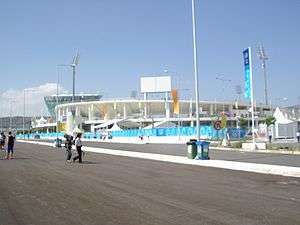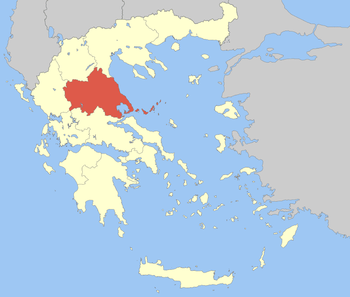Volos
Volos (Greek: Βόλος, [ˈvolos]) is a coastal port city in Thessaly situated midway on the Greek mainland, about 330 kilometres (205 miles) north of Athens and 220 kilometres (137 miles) south of Thessaloniki. It is the sixth most populous city of Greece. It is the capital of the Magnesia regional unit of Thessaly Region. Volos is the only outlet to the sea from Thessaly, the country's largest agricultural region. With a population of 144,449 (2011), it is an important industrial centre, while its port provides a bridge between Europe and Asia.
Volos Βόλος | |
|---|---|
Volos seaside by night | |
 Seal | |
 Volos Location within the region 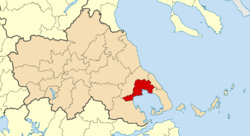 | |
| Coordinates: 39°22′N 22°56′E | |
| Country | Greece |
| Administrative region | Thessaly |
| Regional unit | Magnesia |
| Districts | 18 |
| Government | |
| • Mayor | Achilleas Beos (since 2014) |
| Area | |
| • Municipality | 385.6 km2 (148.9 sq mi) |
| • Municipal unit | 108.6 km2 (41.9 sq mi) |
| Highest elevation | 5 m (16 ft) |
| Lowest elevation | 0 m (0 ft) |
| Population (2011)[1] | |
| • Municipality | 144,449 |
| • Municipality density | 370/km2 (970/sq mi) |
| • Municipal unit | 125,248 |
| • Municipal unit density | 1,200/km2 (3,000/sq mi) |
| Time zone | UTC+2 (EET) |
| • Summer (DST) | UTC+3 (EEST) |
| Postal code | 38x xx |
| Area code(s) | 2421x |
| Vehicle registration | ΒΟx |
| Website | www.volos-city.gr |
Volos is the newest of the Greek port cities, with a large proportion of modern buildings erected following the catastrophic earthquakes of 1955. It includes the municipal units of Volos, Nea Ionia and Iolkos, as well as smaller suburban communities. The economy of the city is based on manufacturing, trade, services and tourism. Home to the University of Thessaly, the city also offers facilities for conferences, exhibitions and major sporting, cultural and scientific events. Volos participated in the 2004 Olympic Games, and the city has since played host to other athletic events, such as the European Athletic Championships. Volos hosted the 7th International Olympiad on Astronomy and Astrophysics from 27 July to 5 August 2013.[2]
Location
Built at the innermost point of the Pagasetic Gulf and at the foot of Mount Pilio (Pelion, the land of the Centaurs). The city spreads in the plain on the foothills of Mount Pelion, bordering the town of Agria to the east and Nea Anchialos to the south west. Volos' municipality includes both towns, along with many nearby villages, including Makrinitsa and Portaria.
Volos is a major commercial port of mainland Greece in the Aegean sea (after Piraeus and Thessaloniki), with connection by ferry and hydrofoil to the nearby Sporades Islands, which include Skiathos, Skopelos and Alonissos. There are also connections to Limnos, Lesvos, Chios and Skyros.
History
Antiquity
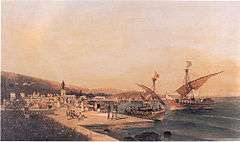
Modern Volos is built on the area of the ancient cities of Demetrias, Pagasae and Iolcos. Demetrias was established in 293 BC by Demetrius Poliorcetes, King of Macedon.[3] Iolcus, or Iolkos, was known in mythology as the homeland of the hero Jason, who boarded the ship Argo accompanied by the Argonauts and sailed in quest of the Golden Fleece to Colchis.[4] To the west of Volos lie the Neolithic settlements of Dimini, with a ruined acropolis, walls, and two beehive tombs dating to between 4000–1200 BC, and Sesklo, with the remains of the oldest acropolis in Greece (6000 BC). The mound of Kastro/Palaia in western Volos is the site of a Bronze Age settlement, including a Mycenaean palace complex where a couple of preserved Linear B tablets have been found.[5][6]
Byzantine era
Iolcus is still attested in the early Byzantine period, but was eclipsed for most of the Middle Ages by Demetrias.[7] The Slavic tribe of the Belegezites settled in the area during the 7th century.[8]
Volos first appears again in 1333, as one of the cities captured by the Byzantine general John Monomachos in Thessaly, under the name "Golos" (Γόλος).[7] The name is of Slavic origin, from golo, golъ, "barren".[9][10] Another theory derives the name from Slavic golosh, "seat of administration".[11] Two alternative theories allude to a Greek origin through the words βολή (throw), as fishermen threw their nets into the sea from that area, and βώλος (piece of land) but the Greek scholar G. Hatzidakis considers them to be paretymologies at best.[9] The modern form of the name is first attested in 1540.[10]
The walls of medieval Golos follow the traces of the fortifications of ancient Iolcus, and many remnants of the ancient city have been found in the medieval citadel.[12]
Along with the rest of Thessaly, Volos fell under Serbian rule in 1348, governed by Gregory Preljub.[13] After Preljub's death Thessaly passed under the brief rule of Nikephoros II Orsini, followed by the Serbian rulers Simeon Uroš and John Uroš. After the latter's death in 1373, Thessaly returned under Byzantine rule for twenty years, until its conquest by the Ottoman Empire under Sultan Bayezid I.[14]
Ottoman era
Ottoman rule was not yet firm. The first period of Ottoman control lasted from 1393–1397, followed by another c. 1403, but it was not until 1423 that Volos was definitively incorporated into the Ottoman Empire.[11] The Ottoman name of the city was Ottoman Turkish: قلز, romanized: Quluz.[11] The Ottomans strengthened the town's fortifications against a possible Venetian attack, and installed not only a garrison, but also Muslim settlers from Anatolia.[11] The local Christian population in turn moved to the slopes of Pelion.[11] From this time on, Volos became the chief settlement on the Pagasetic Gulf.[12]
The city began to spread outside its walls in the late 16th/early 17th centuries, coinciding with a growth in commerce, helped by the citys famed twice-weekly local fair and the first works at the waterfront harvour.[11] The fortress was captured by the Venetians under Francesco Morosini in 1665, during the Cretan War, but recovered and refortified by the Ottomans.[11]
In May 1821, at the beginning of the Greek Revolution, the Greek rebels of Mount Pelion tried to capture the fortress but failed.[11] On 8 April 1827, the Greek fleet, under the command of the British philhellene Frank Abney Hastings, captured five Ottoman ships in the city's harbour and forced the local garrison to evacuate the fortress.[11] The provisional government of Greece claimed Volos as part of Greek national territory, but the Treaty of Constantinople (1832), which established a Greek independent state, set its northern boundary along a line running south from Arta to Volos.[15] Volos was incorporated into the Greek Kingdom in November 1881 with the rest of Thessaly.[11]
Modern Volos

Volos is a relatively new city, beginning its growth in the mid-19th century. The locality of its castle was previously known as Golos by Ottomans and locals .
After its incorporation into the Greek Kingdom, the town had a population of only 4,900, but grew rapidly in the next four decades as merchants, businessmen, craftsmen and sailors gravitated toward it from the surrounding area. In the 1920s a large influx of refugees to the settlement took place, especially from Ionia, but also from Pontus, Cappadocia and Eastern Thrace. In 1882, Andreas Syngros established the Privileged Bank of Epirus and Thessaly, which the National Bank of Greece acquired in 1899 after its founder's death. Volos was occupied by Ottomans on 8 May 1897, during the Greco Turkish War.[16]
The city had a vibrant Jewish community in the early 20th century: from ca. 500 in 1896, it rose to ca. 2,000 in 1930, before falling drastically to 882 members in 1940, because of emigration to the great cities of Thessaloniki and Athens or abroad. During the Axis occupation of Greece, the prompt actions of the local chief rabbi, Moshe Pessach, and the Greek authorities, saved about 700 of the local Jewish community from deportation to the Nazi death camps.[17]
After an aerial attack by Italian troops in November 1940 and another one by the Germans in 1941 many of the city's inhabitants took refuge in the villages of Pelion. Abondoning Volos after Italy's capitulation in September 1943 the Italians left storerooms full of food, arms and ammunition. Large quanties of this material was transported with the Pelion railway to the mountain village Milies and under the supervision of the ELAS loaded on mules and taken to secure hideaways. When the Germans set off a column to Milies an officer and a soldier were killed by restitance fighters. In reprisal nearly the whole village was burnt down by German occupation troops on October 4, 1943. According to the official report of the municipality the Germans executed 25 men and three inhabitants died in their houses by the flames.[18]
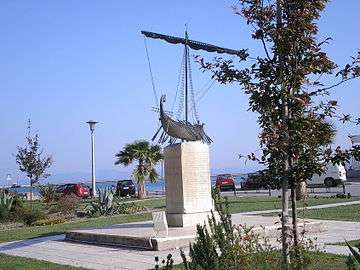
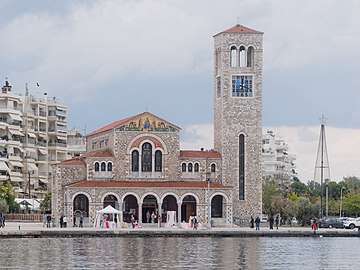 The church of Saints Constantine and Helen at the seafront
The church of Saints Constantine and Helen at the seafront- The city hall
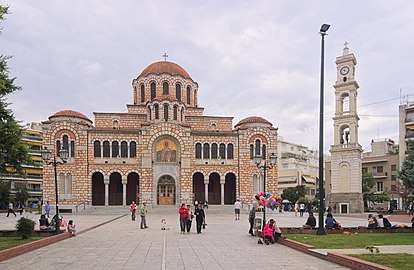 St Nicholas, patron saint
St Nicholas, patron saint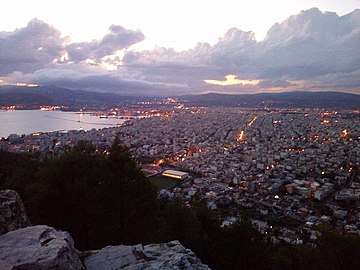 Panoramic view
Panoramic view
Volos is also well known for its assortment of mezedes and a clear, alcoholic beverage known as tsipouro.
A street in a sister city, Rostov-on-Don, bears the name Улица Греческого Города Волос (Street of the Greek City of Volos), weaving through a mix of early 20th-century buildings with characteristic inner yards, tiered balconies and open iron stairs that lend the old Rostov its characteristic Mediterranean look.
Administration
The municipality Volos was formed at the 2011 local government reform by the merger of the following 9 former municipalities, that became municipal units:[19]
The municipality has an area of 385.614 km2, the municipal unit 27.678 km2.[20]
Province
The province of Volos (Greek: Επαρχία Βόλου) was one of the provinces of the Magnesia Prefecture. Its territory corresponded with that of the current municipalities Volos, Rigas Feraios, South Pelion and Zagora-Mouresi.[21] It was abolished in 2006.
Geography
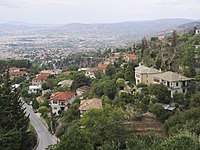
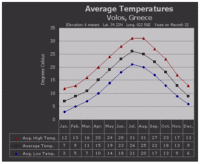
Volos is the administrative centre of the Magnesia regional unit. Many of the city domains are separated through natural barricades, such as rivers.
Three main rivers/mountain torrents all rise from mount Pelion (with its peak at 1,610 metres (5,280 feet)), crossing the city to create a unique urban geography, before ending in the Pagasetic Gulf flowing west. The Anavros river, famous for Jason's pass, divides the Nea Demetriada district from the rest of the urban area. Krafsidonas is the major river passing through the city, and constitutes the natural lung of the urbanized area of Volos, as well as the boundary between the major municipalities of the metropolitan city, the municipalities of Volos and Nea Ionia. Xirias (Ξηριάς), is the largest torrent of the metropolitan urban area of Volos, and passes through the Nea Ionia municipal area.
Climate
Volos, having a Csa Mediterranean climate, typically experiences neither particularly high nor extremely low temperatures throughout the year. Its climate is one of a low humidity, favourable for all kinds of activities. The Pelion mountain, with its own microclimate, affects the city's weather.
| Climate data for Volos (1958–1983) | |||||||||||||
|---|---|---|---|---|---|---|---|---|---|---|---|---|---|
| Month | Jan | Feb | Mar | Apr | May | Jun | Jul | Aug | Sep | Oct | Nov | Dec | Year |
| Record high °C (°F) | 23.0 (73.4) |
24.7 (76.5) |
26.0 (78.8) |
34.0 (93.2) |
35.2 (95.4) |
45.3 (113.5) |
44.2 (111.6) |
39.6 (103.3) |
36.8 (98.2) |
30.4 (86.7) |
27.2 (81.0) |
24.4 (75.9) |
45.3 (113.5) |
| Average high °C (°F) | 11.3 (52.3) |
12.9 (55.2) |
15.0 (59.0) |
19.4 (66.9) |
24.0 (75.2) |
28.5 (83.3) |
31.0 (87.8) |
30.6 (87.1) |
27.0 (80.6) |
21.7 (71.1) |
17.3 (63.1) |
13.2 (55.8) |
21.0 (69.8) |
| Daily mean °C (°F) | 7.8 (46.0) |
9.0 (48.2) |
11.3 (52.3) |
15.4 (59.7) |
20.1 (68.2) |
24.6 (76.3) |
27.0 (80.6) |
26.6 (79.9) |
22.9 (73.2) |
17.7 (63.9) |
13.3 (55.9) |
9.6 (49.3) |
17.4 (63.3) |
| Average low °C (°F) | 4.5 (40.1) |
5.4 (41.7) |
7.3 (45.1) |
10.5 (50.9) |
14.9 (58.8) |
19.0 (66.2) |
21.3 (70.3) |
21.2 (70.2) |
17.9 (64.2) |
13.6 (56.5) |
9.8 (49.6) |
6.3 (43.3) |
12.6 (54.7) |
| Record low °C (°F) | −8.2 (17.2) |
−7.8 (18.0) |
−3.2 (26.2) |
1.8 (35.2) |
6.2 (43.2) |
11.6 (52.9) |
14.0 (57.2) |
14.8 (58.6) |
9.2 (48.6) |
1.4 (34.5) |
0.6 (33.1) |
−6.0 (21.2) |
−8.2 (17.2) |
| Average precipitation mm (inches) | 58.4 (2.30) |
35.4 (1.39) |
40.5 (1.59) |
27.3 (1.07) |
32.5 (1.28) |
22.5 (0.89) |
15.1 (0.59) |
10.9 (0.43) |
35.0 (1.38) |
51.8 (2.04) |
52.2 (2.06) |
47.2 (1.86) |
428.8 (16.88) |
| Average precipitation days (≥ 1.0 mm) | 10.5 | 9.7 | 9.9 | 8.2 | 6.6 | 5.2 | 2.8 | 2.7 | 5.3 | 8.1 | 10.1 | 10.1 | 89.2 |
| Average relative humidity (%) | 72.7 | 70.0 | 69.5 | 65.7 | 65.0 | 61.2 | 58.1 | 60.1 | 65.5 | 70.4 | 74.0 | 73.7 | 67.2 |
| Mean monthly sunshine hours | 104.7 | 117.8 | 157.5 | 213.8 | 266.3 | 307.2 | 337.1 | 320.1 | 247.6 | 171.8 | 126.0 | 101.0 | 2,470.9 |
| Source: Meteovolos[22] | |||||||||||||
Architecture
Volos used to have plenty of old mansions, the majority of which was destroyed after the earthquakes in 1955. Nowadays, only some of them have been saved, restored and have a new, mainly public, use.
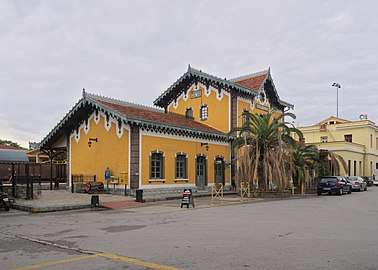 The railway station, designed by Evaristo De Chirico.
The railway station, designed by Evaristo De Chirico.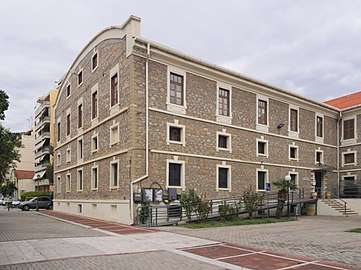 The old Spierer tobacco warehouse
The old Spierer tobacco warehouse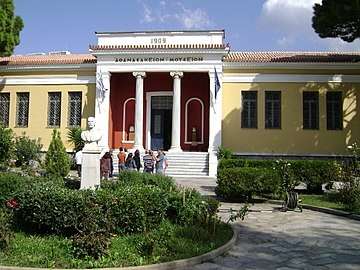 Archaeological Museum of Volos
Archaeological Museum of Volos
The development of the new city coincided with the flourishing of neoclassicism. Public buildings conformed to this style and prestigious private buildings belonging to prosperous merchants were particularly sophisticated. Typical examples include:
- The 3-storeyed Hotel de France, with its impressive decorative murals (1894, Iasonos and K. Kartali Street)
- Old Tobacco Factory of Matsaggos (1890)
- Yellow Tobacco Warehouse (1926)
- The National Bank, formerly the Epirothessalian Bank (1895)
- The Athens Bank (1903, today the library of University of Thessaly)
- The Achillopouleion Hospital (1901)
- The Archaeological Museum of Volos, Athanasakeio (1909)
- The Agricultural Bank (1909, formerly the Kosmadopoulos Bank)
- The Cine-theater Achilleion (1925)
- The Aegli Hotel, (1927), designed by Kassiopoulos
- The Building of the Air-force High officials Club near Agios Konstantinos Park, believed to have been designed by Le Corbusier
- The Bank of Greece building (1935)
- Municipal conservatory of Volos
- The old factory of Tsalapatas
- Tsikrikis Mansion
- Kitsos Makris' house (today Kitsos Makris Folklore Centre)
- Volos City Hall
- The Railway Station of Volos, designed by Evaristo De Chirico
- The Averofeian Courthouse
- The family houses of Kartalis, Glavanis, Kastemis, Saratsis
- The Sarafopoulos Mansion (1927), today the Volos Club
- The well preserved Regas house and its singular decorative murals, today the Lyceum of Greek women
Districts

|
City Centre (35,420)
|
North (15,000)
|
North-West (33,000)
|
Education
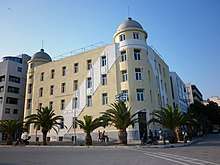
The city of Volos consists of the administrative and academic centre of University of Thessaly, which was founded in 1984, and is the most important centre of education in central Greece. The faculties of Engineering, Humanities and Social Sciences and Agricultural Sciences with their twelve Departments are based in Volos, enforcing the academic, economic and cultural development of the city. The faculties are located in different places in the city. “Pedion Areos” Campus is used by the Departments of the School of Engineering, while the School of Humanities and Social Sciences is located in the centre of the city. The School of Agricultural Sciences is based in a renovated building in Fytoko. In addition to Greek students, the city and the University attract many foreign students via Erasmus and other programmes.
Moreover, in the city there are 56 kindergartens, 51 primary schools, 18 junior high schools and 13 senior high schools.
Economy
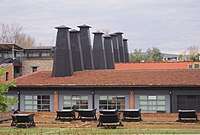
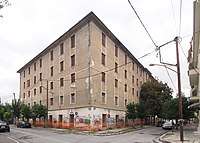
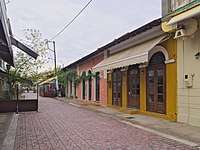
Volos is one of the most industrialized provincial cities of Greece, because of its strategic location between the largest population centers of the country (Athens – Thessaloníki) and its port. Industry is intensely specialized in steel production and manufacturing. Three major steel producers (METKA, SIDENOR and Hellenic Steel Industry (Ελληνική Χαλυβουργία)) have production facilities in the industrial areas of Volos and nearby Almyros. AGET Heracles, a member of the Lafarge group, operates one of the largest cement facilities in the world (with capacity exceeding 7,000,000 tn[23]) with its own private port, next to the city. Volos is also active in the research sector, hosting the Institute of Bio-Economy and Agri-Technology (iBO), one of the five Institutes of the Center for Research and Technology – Hellas (CERTH).[24]
Port
The port that lies upon ancient Iolkos where one of the most legendary sea. Here, at the safe port of the Pagasitikos bay, Jason built his trireme, Argo, and along with his oarsmen set course for Colhis bringing back and marrying priestess Medea. The new port was founded in 1893 and was the most significant element for the industrial development of the area. Today, Volos has the third-largest cargo port in Greece (after Piraeus and Thessaloniki), carrying agricultural and industrial products. In the past there was connection with Tartus in Syria.
Ferries and flying dolphins operate daily connecting Volos to Magnesia islands, Sporades (Skiathos, Skopelos, Alonissos). Moreover, many cruise ships use the port of Volos as a destination. During the summers of 2015 and 2016, more than 100 cruises arrived in Volos, carrying more than 100.000 visitors.[25]
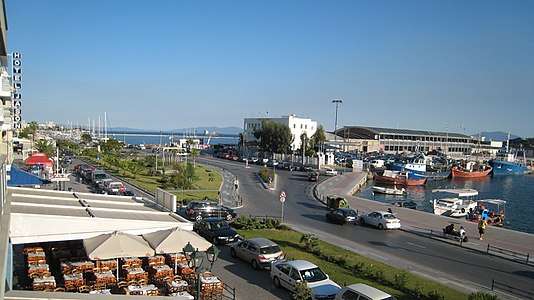 View of the port.
View of the port.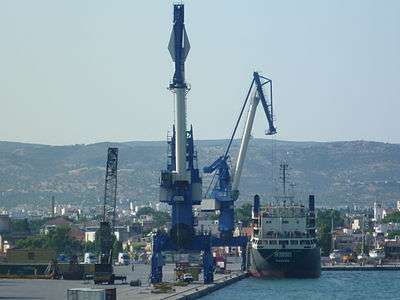 Cargo ship at the harbour.
Cargo ship at the harbour.- The promenade
International relations
The city of Volos has always had a major role in the financial, economic, commercial and administrative matters of the region of Thessaly and Central Greece, due to the strategic position of the city's port, unique between Athens and Thessaloniki.
International consulates
Several European countries have established consulates in Volos including:
Twin towns — sister cities
Volos is twinned with:[26]







Culture
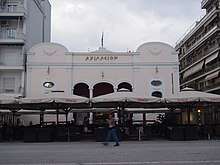
The wider region of Volos is a place with great history, finding the first signals of culture in the Neolithic period. In the villages Sesklo and Dimini have been discovered the first findings of Neolithic culture in Europe.
Moreover, close to Volos there are the ancient Dimitrias, a town that was built by Dimitrios Poliorkitis in 294-2 AC. Today, the ancient theater of Dimitrias is saved. There are also the archaeological region of Goritsa hill, findings of Old-Christian period in Nea Anchialos and the wall of the old castle of Volos that someone can visit.
Volos consists of a city with various Greek trades, as the industrial development and the port conducted many people move in the city. The industrial and financial evolution of the city conducted in a cultural and social evolution too. In 1894, Volos acquired its Municipal Theater and in 1896 the Volos Gymnastic Club. In 1908, in Volos was founded the first Labor Union in Greece. After 1922 with the Asia Minor Catastrophe, Volos received a large number of people coming from the destroyed regions. This coexistence with the locals influenced deeply the culture of the city, making this influence visible in the food, music, sports, entertainment and social life of the city. Nowadays, there is a plenty of museums and galleries spread in the city, but also in the wide region. Moreover, Volos consists one of the most attractive and touristic cities in Greece because of its physical attributes combining the Pagasetic Gulf with the Mount Pelion. Volos is a candidate city for the European Capital of Culture in 2021.[27]
Museums and galleries
- Archaeological Museum of Volos[28]
- Volos Natural History Museum
- Modern History Museum of Volos City[29][30]
- Thessaly Railway Museum, Railway Station of Volos
- The Rooftile and Brickworks Museum N. & S. Tsalapatas, National Museum of Industrial History[31]
- Entomological Museum of Volos [32]
Cuisine
One of the main characteristics and touristic specialities of Volos is the traditional drink tsipouro and the sea food that is served accompanying the drink.
Local specialities include:
- Boubari
- Spetzofai
- Melachrini (dessert)
- Spoon sweets
- Tsipouro (drink)
Sports
Volos, taking advantage of its physical attributes by the sea, has a significant presence in Greek sport history in racing rowing (sport) and sailing (sport). Furthermore, Volos has two closed and one open swimming pools, presenting a long history in swimming and water polo. Moreover, Volos has many clubs and facilities in several sport such as football, basketball, volleyball, tennis, horse-riding. The most popular clubs, with great offer in sport and cultural history of the city and significant successes in football, are Olympiakos Volou and Niki Volou. The main clubs of Volos are shown below.
| Sport clubs based in Volos | |||
|---|---|---|---|
| Club | Founded | Sports | Achievements |
| Niki Volou | 1924 | Football, Basketball and other sports | Presence in A Ethniki football |
| N.C. Volos-Argonauts | 1932 | Water Polo | Presence in A1 Ethniki women |
| Olympiakos Volou | 1937 | Football, Basketball and other sports | Europa League participant, earlier presence in A Ethniki football, panhellenic title in women basketball |
| Hippotis equestrian club | 2002 | Horse riding | Presence in National competitions |
| Volos 2004 | 2004 | Football | Presence in A Ethniki women |
| Volos F.C. | 2017 | Football | Presence in A Ethniki football |
Volos used to be one of the five cities that hosted the 2004 Summer Olympics.
Volos after 2004, has hosted in its facilities significant sports events such as 27th European Championship of Artistic Gymnastics in 2006, the FIBA European Championship of Young Men (2015) when Greece acquired the gold medal and the Final of Greek Football Cup in 2007 and 2017.
Transport
All land transport reaches Volos, while the International Airport of Central Greece in Nea Anchialos links the city to international destinations, and the Port of Volos provides links to the islands, mostly the Sporades, as well as to some destinations in Pilio.
Motorways
Volos is linked through Greece's E75 Highway Axis (most often known as PATHE) with Northern and Southern Greece. Beyond this, the Axis E65 will be the gateway to Western Greece and the port of Igoumenitsa, through the plains of inner Thessaly; this part of the E65 motorway will be completed by 2012.
Airport
The city of Volos, along with the rest of Central Greece, is linked to the rest of Greece and Europe by the Nea Anchialos National Airport. The airport has the second longest commercial runway in Greece after Eleftherios Venizelos.
Volos is the first city in Europe to feature Seaplane Services through Argo Airways, which is based in Volos. The seaplanes connect Volos with Skiathos, Skopelos, Allonisos, Athens and Thessaloniki.
Railway
Today, the city is served by direct lines to the rest of Greece, and the railway complex houses facilities for train maintenance. Volos is directly linked with Athens once per day, with Thessaloniki twice per day, and with Larissa 15 times a day. In the past Volos was served by railway lines of three different gauges, the metre gauge line of Thessaly Railways to Kalampaka, the standard gauge line to Larissa and the 600 mm (1 ft 11 5⁄8 in) gauge line to Pelion. Remnants of triple gauge lines still exist near the station. Currently, the Pelion railway line operates for touristic reasons every Saturday, Sunday and public holiday from mid-April to the end of October. The train runs every day during July and August.
Notable people
.jpg)
Modern
- Giorgio de Chirico, painter (1888–1978)
- Vangelis, composer (1943)
- John Argyris, pioneer in engineering, Professor of Imperial College London and University of Stuttgart (1913–2004)
- Fotis Kouvelis, politician, leader of the Democratic Left
- Dimitrios Trichopoulos, medical doctor, Professor of Harvard School of Public Health
- Georgios Kartalis, politician (1908–1957)
- Yorgos Foudoulis, musician and composer (1964)
- Moshe Pesach, rabbi of Volos and Chief Rabbi of Greece
- Lavrentis Mahairitsas, musician and songwriter (1956-2019)
- Artemis Alexiadou, linguist (1969)
- Yorgo Moutsiaras, orchestral conductor (1976)
Athletes
- Vasileios Polymeros, rower, olympic medalist (1976)
- Nikolaos Skiathitis, rower, olympic medalist (1981)
- Olga Vasdeki, triple jumper (1973)
- Spyridon Vasdekis, long jumper (1970)
- Paraskevi Tsiamita, triple, long jumper (1972)
- Nikos Boudouris, basketball player (1971)
- Panagiotis Liadelis, basketball player (1974)
- Athanasios Kostoulas, football player (1976)
- Efthalia Koutroumanidou, beach volleyball player (1982)
- Evanthia Makrygianni, synchronized swimmer (1986)
- Christos Volikakis, track cyclist (1988)
- Adam Tzanetopoulos, football player (1995)
See also
Footnotes
- "Απογραφή Πληθυσμού - Κατοικιών 2011. ΜΟΝΙΜΟΣ Πληθυσμός" (in Greek). Hellenic Statistical Authority.
- http://www.ioaa2013.gr/ 7th International Olympiad on Astronomy and Astrophysics official website
- Helly, Bruno (2012). "Demetrias". In Hornblower, Simon (ed.). The Oxford Classical Dictionary (4th ed.). Oxford University Press. doi:10.1093/acref/9780199545568.001.0001. ISBN 9780191735257. Retrieved 11 June 2020.
- Hunter, R. (2012). "Jason". In Hornblower, Simon (ed.). The Oxford Classical Dictionary (4th ed.). Oxford University Press. doi:10.1093/acref/9780199545568.001.0001. ISBN 9780191735257. Retrieved 11 June 2020.
- Dickinson, Oliver T. P. K. (2012). "Iolcus (mod. Volos)". In Hornblower, Simon (ed.). The Oxford Classical Dictionary (4th ed.). Oxford University Press. doi:10.1093/acref/9780199545568.001.0001. ISBN 9780191735257. Retrieved 11 June 2020.
- Asderaki-Tzoumerkioti, E.; Rehren, Th.; Skafida, E.; et al. (2017). "Kastro Palaia settlement, Volos, Greece: a diachronical technological approach to bronze metalwork". STAR: Science & Technology of Archaeological Research. 3 (2): 179–193. doi:10.1080/20548923.2018.1427182. Retrieved 11 June 2020.
- Koder, Johannes; Hild, Friedrich (1976). Tabula Imperii Byzantini, Band 1: Hellas und Thessalia (in German). Vienna: Verlag der Österreichischen Akademie der Wissenschaften. p. 165. ISBN 978-3-7001-0182-6.
- Koder, Johannes; Hild, Friedrich (1976). Tabula Imperii Byzantini, Band 1: Hellas und Thessalia (in German). Vienna: Verlag der Österreichischen Akademie der Wissenschaften. p. 56. ISBN 978-3-7001-0182-6.
- Hatzidakis, G. N. (1930). "Γόλος–Βόλος". Ἐπετηρίς Ἐταιρείας Βυζαντινῶν Σπουδῶν (in Greek). 7: 231–233. hdl:11615/19950.
- Vasmer, Max (1941). Die Slawen in Griechenland. Berlin: Verlag der Akademie der Wissenschaften. pp. 108–109.
- Savvides, A. (2004). "Ḳuluz". In Bearman, P. J.; Bianquis, Th.; Bosworth, C. E.; van Donzel, E. & Heinrichs, W. P. (eds.). The Encyclopaedia of Islam, New Edition, Volume XII: Supplement. Leiden: E. J. Brill. p. 544. ISBN 90-04-13974-5.
- Koder, Johannes; Hild, Friedrich (1976). Tabula Imperii Byzantini, Band 1: Hellas und Thessalia (in German). Vienna: Verlag der Österreichischen Akademie der Wissenschaften. p. 166. ISBN 978-3-7001-0182-6.
- Soulis, George C. (1984). The Serbs and Byzantium during the reign of Emperor Stephen Dušan (1331–1355) and his successors. Dumbarton Oaks. pp. 108–110. ISBN 0-88402-137-8.
- Koder, Johannes; Hild, Friedrich (1976). Tabula Imperii Byzantini, Band 1: Hellas und Thessalia (in German). Vienna: Verlag der Österreichischen Akademie der Wissenschaften. pp. 75–76. ISBN 978-3-7001-0182-6.
- Comstock, John (1829). History of the Greek Revolution. New York: W. W. Reed & co. p. 5.
- Cathy Gere (2010). Knossos and the Prophets of Modernism. University of Chicago Press. p. 99. ISBN 978-0-226-28955-7.
- Shmuel Spector; Geoffrey Wigoder, eds. (2001). "Volos". The Encyclopedia of Jewish Life Before and During the Holocaust, Volume 3: Seredina-Buda–Z. New York: New York University Press. pp. 1411–1412. ISBN 9780814793787.
- Helen F. Stamati: Milies: A Village on Mount Pelion, Athens 1989, p. 54–59.
- Kallikratis law Greece Ministry of Interior (in Greek)
- "Population & housing census 2001 (incl. area and average elevation)" (PDF) (in Greek). National Statistical Service of Greece.
- "Detailed census results 1991" (PDF). (39 MB) (in Greek and French)
- "Volos Climate Normals 1958–1983". Hellenic National Meteorology Service. Retrieved June 18, 2014.
- "AGET Hraklis Facilities". Archived from the original on 2008-02-08. Retrieved 2007-11-08.
- "Ξεχάσαμε τα… αδέρφια μας ~ Αδελφοποιήσεις Δήμων που έμειναν τυπικές". taxydromos.gr (in Greek). Taxydromos. 2014-11-17. Retrieved 2020-01-11.
- Volos 2021
- vagelis tsekeris. "Archaeological Museum of Volos". Travelinfo.gr. Archived from the original on 2010-06-29. Retrieved 2009-07-27.
- "Archived copy". Archived from the original on 2007-07-01. Retrieved 2007-06-13.CS1 maint: archived copy as title (link) Modern History Museum of Volos City
- "ΜΟΥΣΕΙΟ ΠΟΛΗΣ – Σχεδιασμός". www.i-politismos.gr. Archived from the original on 2009-01-30. Retrieved 2009-07-27.
- "Piraeus Bank Group Cultural Foundation". Piop.gr. Retrieved 2009-07-27.
- http://www.entomologikomouseio.gr/
References
- Kordatos, Ioannis (1977). Η Επανάσταση στην Θεσσαλομαγνησία το 1821 [The Revolt in Thessalomagnesia in 1821] (in Greek). Athens: Epikairotita.CS1 maint: ref=harv (link)
External links

- Volos The Official website of the Greek National Tourism Organisation
- Homepage of the Municipality of Nea Ionia
| Wikimedia Commons has media related to Volos. |
